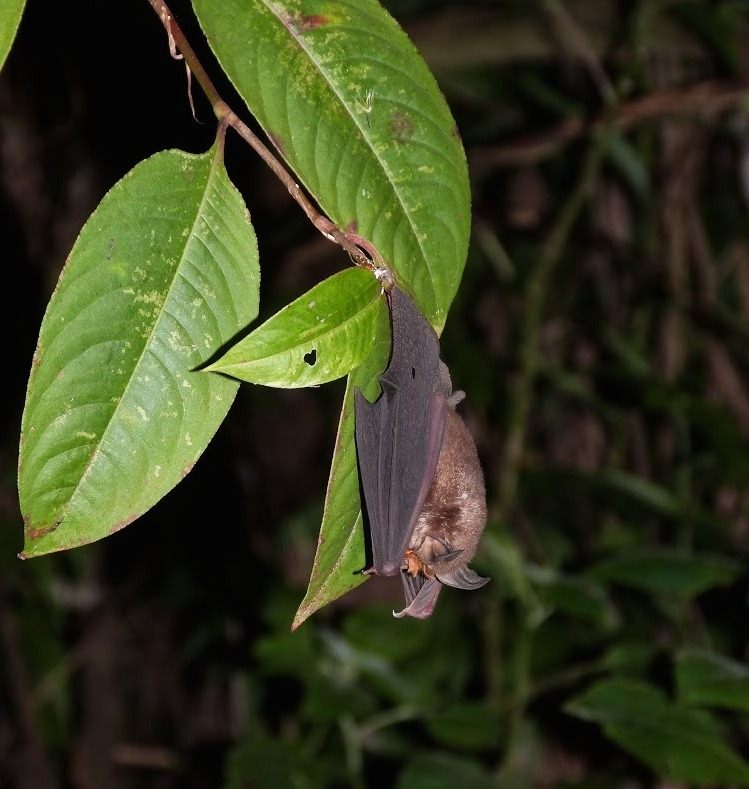Coffee Bats, Farm Chimps, And Other Animals Making Do In Developed Habitats

A chimpanzee balances on a recently logged eucalpytus. (Photo: Jack Lester/BMC Ecology)
As the world gets increasingly chopped up and paved over, conservationists are turning their attention to places that are less wild—and some are finding, to their surprise, that the wildlife there is doing okay.
Scientists have found sun bears trundling through pulpwood stands, and endangered gorillas treating cramped stretches of forest like highways between larger ones. According to one study, over 75 percent of orangutans live in timber concessions.
“There have been numerous studies in recent years highlighting the fact that various species can survive outside protected areas,” says chimpanzee specialist Maureen McCarthy. When conservationists ask how different species are faring in this new paradigm, the answers are less bleak than our own lines in the sand might lead us to believe. “There is a shift occurring whereby the dichotomy between natural environments and human-impacted environments is breaking down,” McCarthy says.
Take the bats of the Ghats. The Western Ghats, a forested mountain range that runs parallel to the west coast of India, is a biodiversity hotspot. It’s prime habitat for thousands of plant species and hundreds of kinds of amphibians and mammals. It’s also home to an enormous number of people, who need to mow the plants and displace the animals in order to be able to live there.
Claire Wordley studies one subset of this diverse population: bats, specifically bats making do in and around the Valparai Plateau, which has been heavily planted with tea, coffee, and other cash crops for centuries. As Wordley points out, although “protected areas are fantastic,” they make up just over 10 percent of the world’s landed surface area—“we sort of need to know how biodiversity is going to fare in the other 90 percent, the farmland and the urban areas and all the rest of it,” she says.

A Blyth’s horseshoe bat, made in the shade of a coffee plantation. (Photo: Claire Wordley/Biological Conservation)
Wordley and her colleagues at the University of Leeds, the National Center for Biological Sciences, and the Nature Conservation Foundation mapped out bat habitats in the area, and kept track of where different species tend to hang out. They released their findings last week in Biological Conservation.
They discovered that while bats hardly ever choose to live among the tea plants (and most animals don’t—some conservationists call tea plantations “green deserts”)–they do enjoy flapping around the coffee bushes. In fact, the bats in the bushes planted under the canopies of trees there “were doing almost as well as they would do in a small forest patch,” Wordley says. If there are enough forest fragments, coffee spots, and rivers around, some bats will even put in a little tea time.
It’s not just bats who like hanging out on the coffee grounds. “There’s a lot living there,” Wordley says. “When you walk through one of these shade coffee plantations, if you don’t see at least a couple of different species of primate, and half a dozen different butterfly species… I’d be quite surprised.”

A mosaic of tea plantations and regenerating forests. (Photo: Claire Wordley/Biological Conservation)
Three thousand miles away, in Uganda’s Northern Albertine Rift, Maureen McCarthy of the University of Southern California has been tackling similar questions. The Rift lies between two protected areas, the Budongo and Bugoma forests, each of which house healthy populations of chimpanzees. But the Rift itself is a mosaic of towns, farms, and grasslands, with a few small reserves thrown in. A lot of people live there, but what about chimps? McCarthy decided to investigate.
She and her colleagues found about three times as many chimpanzees as they had expected. While they chalked some of this up to more accurate census methods—instead of nest-based guessing, they collected chimp poop and genotyped it—some of it was just plain good news.
“Chimpanzees are both numerous and widespread in the human-dominated landscape between the Budongo and Bugoma Forests,” they write in their study, which was published last week in BMC Ecology. “Our results… imply that elusive and rare species may adapt to degraded habitats more successfully than previously believed.”

Three chimps pant and hoot in what was recently a forest. (Photo: Maureen McCarthy/BMC Ecology)
McCarthy is careful to emphasize that the long-term survival of animals in a developed area should not be taken for granted—any human-dominated environment is full of hammers that might yet fall. Chimps, for example, are genetically similar enough to humans that close contact might make them more susceptible to disease.
And, some of their inherent flexibility includes switching their diets from wild fruit to human crops, which could bring them into conflict with their new neighbors. “In areas where hunting pressure on chimpanzees is high,” she writes, “this sort of coexistence would not be expected.”

A chimp crosses a footpath built for humans. (Photo: Jack Lester/BMC Ecology)
Wordley echoes these sentiments, putting equal weight on the optimism of her findings with bats, and the hard work that remains. Some of that work lies with conservationists, and some with those who coexist directly with wildlife.
But a fair share lies with consumers, who create the vacuum of demand that shapes the land from far away. “Your caffeinated drink choices do have a real impact,” Wordley says. Although it can cost more at cafés and shops, shade-grown coffee “is great coffee.”
It must be, if bats like it so much.

Or maybe the bats are just hipsters. (Image: Rohan Chakravarty/Biological Conservation)
Naturecultures is a weekly column that explores the changing relationships between humanity and wilder things. Have something you want covered (or uncovered)? Send tips to cara@atlasobscura.com.

















Follow us on Twitter to get the latest on the world's hidden wonders.
Like us on Facebook to get the latest on the world's hidden wonders.
Follow us on Twitter Like us on Facebook